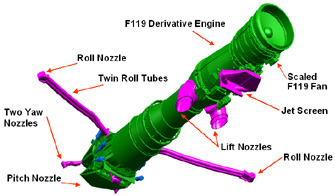In the question:Why do VTOL aircraft (F-35 or Harrier) have only one engine? Aeroailas answered why mature STOVL fighter designs only use one main engine, but did not answer why there are no mature twin-engine STOVL fighter designs.
Also in the question Is it possible to modify an AV-8B Harrier II to a supersonic aircraft by applying some modification? He has shown the BS100 engine, adding an aftburner to plenum chamber for supersonic flight.
Carlo Felicione, in his answer to Why does the Harrier jet have four landing gears? , said that the two aft nozzles forced Harriers to adapt bicycle landing gears.
 Close-up of P.1127 Kestrel (Harrier prototype) shot by Alan Wilson under CC-SA 2.0 licence.
Close-up of P.1127 Kestrel (Harrier prototype) shot by Alan Wilson under CC-SA 2.0 licence.
Layout of the Pegasus. Public domain.
Power system of Boeing X-32, archived by globalsecurity.org.
The only other mature STOVL system utilizing direct lift is that from X-32.
 Hawker Sea Hawk shot by Smudge 9000 under CC-SA 2.0 licence.
Hawker Sea Hawk shot by Smudge 9000 under CC-SA 2.0 licence.
Harriers seem to inherit elements from Sea Hawk, that the exhaust from a single engine is diverted to two side exhausts.
However, now I am even more confused by the design. The following are my questions.
Why does Pegasus engine have two widely seperated aft (hot) nozzles instead of one straight TVN? Even if the thrust loss is negligible, isn't the extra need for strength and heat management increasing weight?
Cont. to Q1, why Harriers place their tail assembly between such nozzles? From the pic above, anything in that tail has to be protected by extra panels, and the width of the it is limited by the separation of the nozzles. Wouldn't it be better to have aft exhausts at side-bottom in the further aft like Yak-38? Between two tail booms like P.1216, Yak-141 and (X)F-35? Sheath the exhaust in a duct like X-32? Or elevate the tail assembly like Phantoms? Any of them will eliminate the need for bicycle landing gears.
Again, why are the two bow (cold) nozzles so widely separated? The air is forced through 90° bypasses after leaving LP compressor, and another 90° before exit. What would be the thrust loss and strength requirement?
Cont. to Q3, why are the two bow nozzles in the same height of aft nozzles? As I see from the pic, the cold exhaust directly blows onto the aft nozzles (or their farings). If it is fine for cold exhaust to zig-zag through the bypasses, wouldn't it be better to travel smoother bypasses (like 135°-135° bents) to the side-bottom, at least to a lower height than the aft nozzles?
Cont. to Q4, or is it possible to just bleed cold exhaust into one TVN at the bottom of fuselage? (The Harriers' gun and ammo pods are located at two sides of the fuselage, so they shouldn't be a hurdle.)
Cont. to Q3, when in level flight, why not retract the bow nozzles, and let cold exhaust flow into a straight bypass around engine core, and mix with hot exhaust to be expelled from the aft? This will streamline the fuselage to better suit supersonic flight. Also this will ease the placement of aftburners, rather than in the cramped plenum chambers.
Why X-32 still uses two awkward-shaped lift nozzles for vertical landing, while it has (unlike Harriers) plenty of space as well as heat-proof linings in the exhaust duct to transform into a single, central, downward TVN?
Harriers have their Pegasi in their CoM to balance when hovering, making two pairs of nozzles rather close to CoM and to each other. Is it possible to have larger separations? E.g. Place engine core and aft nozzle to further aft, and LP compressor and bow nozzles to further bow, only to be connected with a central shaft, so that the extra space around the shaft can be streamlined and holds more fuel and ordnance.
What are the blades in the nozzles called? Are they necessary, as they aren't seen in later generations' designs?
Is it possible to go shaftless in transmitting power from the core engine to the front lift component in any STOVL configurations (as proposed in McDonnell-Douglas' JSF)?
Is it possible to have twin-engine STOVL jets? E.g. combine two Pegasi to build a heavy fighter, somewhat a supersonic Do-31.




